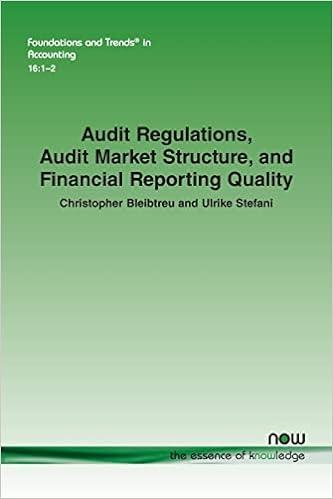Question
Sam and Robert are identical twins. They opened identical businesses and experienced identical transactions. However, they decided to estimate uncollectible accounts in different ways. Sam
Sam and Robert are identical twins. They opened identical businesses and experienced identical transactions. However, they decided to estimate uncollectible accounts in different ways. Sam elected to use the percentage of sales method, and Robert elected to use the percentage of receivables method. Listed below are the beginning balances of Cash, Accounts Receivable, and Allowance for Doubtful Accounts [items (a)(c)], and summary transactions that occurred during the year [items (d)(g)] for both businesses. Remember, both businesses experienced the same events: credit sales, collections of receivables, and write-offs. The only difference between the businesses is the method of estimating uncollectible accounts.
| Robert | |
|---|---|
| (a) Balance of Cash, January 1, 20-- | $300,000 |
| (b) Balance of Accounts Receivable, January 1 | 50,000 |
| (c) Balance of Allowance for Doubtful Accounts, January 1 | 5,000 |
| (d) Sales on account during 20-- | 550,000 |
| (e) Collections on account during 20-- | 530,000 |
| (f) Uncollectible accounts written off during 20-- | 4,500 |
| (g) Collections made on accounts written off during 20-- | 500 |
Required:
| 6. | Prepare entries in a general journal (page 4) for summary transactions (d) through (g) for Robert. |
| 7. | Post the entries to a general ledger for Robert, using the same accounts and numbers as were used for Sam. |
| 8. | Robert bases the estimate of uncollectible accounts on an aging schedule of accounts receivable. Using the following information, compute the estimated uncollectible amounts and make the appropriate adjusting entry in a general journal. Post the entry to the general ledger accounts on December 31, 20--. |
| Customers | Invoice Dates and Amounts for Unpaid Invoices | |||||
|---|---|---|---|---|---|---|
| Beets, D. | 10/7 | $2,300 | 11/15 | $1,200 | 12/18 | $8,500 |
| Cook, L. | 6/1 | 1,200 | 8/15 | 2,500 | ||
| Hylton, D. | 9/23 | 4,300 | 10/22 | 2,500 | 12/23 | 2,800 |
| Martin, D. | 10/15 | 5,400 | 11/12 | 3,200 | 12/15 | 1,500 |
| Stokes, D. | 9/9 | 200 | 12/15 | 9,500 | ||
| Taylor, T. | 11/20 | 400 | 12/10 | 1,400 | ||
| Thomas, O. | 12/2 | 5,500 | ||||
| Tower, R. | 12/15 | 2,300 | ||||
| Williams, G. | 11/18 | 2,800 | 12/8 | 8,000 | ||
All sales are billed n/30. The following aging chart is used to estimate the uncollectibles using the percentage of receivables method:
| Estimated Percent | |
|---|---|
| Age Interval | Uncollectible |
| Not yet due | 2% |
| 130 days | 5 |
| 3160 days | 10 |
| 6190 days | 25 |
| 91120 days | 50 |
| Over 120 days | 80 |
| 9. | Compute the net realizable value of Roberts accounts receivable on December 31, 20--. |
Step by Step Solution
There are 3 Steps involved in it
Step: 1

Get Instant Access to Expert-Tailored Solutions
See step-by-step solutions with expert insights and AI powered tools for academic success
Step: 2

Step: 3

Ace Your Homework with AI
Get the answers you need in no time with our AI-driven, step-by-step assistance
Get Started


